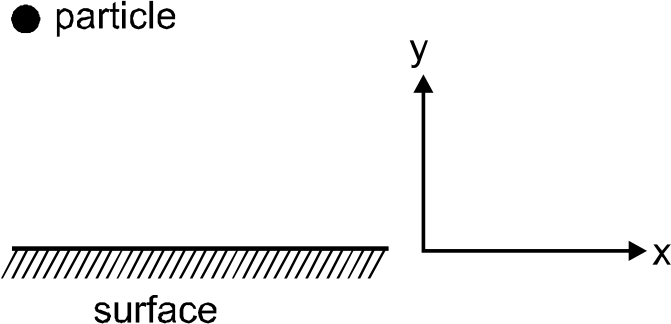A particle of mass m moving with a velocity (3ˆi+2ˆj)ms−1 collides with another body of mass M and finally moves with velocity (−2ˆi+ˆj)ms−1. Then during the collision
The correct Answer is:B, D
To solve the problem, we will calculate the impulse experienced by the particle during the collision. The impulse can be determined by finding the change in momentum of the particle.
1. Identify Initial and Final Velocities:
- The initial velocity of the particle is given as →vi=3^i+2^jm/s.
- The final velocity of the particle after the collision is given as →vf=−2^i+^jm/s.
2. Calculate Initial Momentum:
- The momentum of the particle before the collision can be calculated using the formula:
→pi=m→vi=m(3^i+2^j)=3m^i+2m^j
3. Calculate Final Momentum:
- The momentum of the particle after the collision is:
→pf=m→vf=m(−2^i+^j)=−2m^i+m^j
4. Calculate Change in Momentum:
- The change in momentum Δ→p is given by:
Δ→p=→pf−→pi
- Substituting the values:
Δ→p=(−2m^i+m^j)−(3m^i+2m^j)
- Simplifying this:
Δ→p=(−2m−3m)^i+(m−2m)^j=−5m^i−m^j
5. Calculate Impulse:
- The impulse →J experienced by the particle is equal to the change in momentum:
→J=Δ→p=−5m^i−m^j
6. Final Answer:
- Therefore, the impulse during the collision is:
→J=−5m^i−m^j
- The initial velocity of the particle is given as →vi=3^i+2^jm/s.
- The final velocity of the particle after the collision is given as →vf=−2^i+^jm/s.
- The momentum of the particle before the collision can be calculated using the formula:
→pi=m→vi=m(3^i+2^j)=3m^i+2m^j
- The momentum of the particle after the collision is:
→pf=m→vf=m(−2^i+^j)=−2m^i+m^j
- The change in momentum Δ→p is given by:
Δ→p=→pf−→pi
- Substituting the values:
Δ→p=(−2m^i+m^j)−(3m^i+2m^j)
- Simplifying this:
Δ→p=(−2m−3m)^i+(m−2m)^j=−5m^i−m^j
- The impulse →J experienced by the particle is equal to the change in momentum:
→J=Δ→p=−5m^i−m^j
- Therefore, the impulse during the collision is:
→J=−5m^i−m^j
Topper's Solved these Questions
- CENTRE OF MASS, LINEAR MOMENTUM AND COLLISIONBook:DC PANDEY ENGLISHChapter:CENTRE OF MASS, LINEAR MOMENTUM AND COLLISIONExercise:Level 2 Comprehension Based
Explore 4 Videos
- CENTRE OF MASS, LINEAR MOMENTUM AND COLLISIONBook:DC PANDEY ENGLISHChapter:CENTRE OF MASS, LINEAR MOMENTUM AND COLLISIONExercise:Level 2 Comprehension Based Questions
Explore 3 Videos
- CENTRE OF MASS, LINEAR MOMENTUM AND COLLISIONBook:DC PANDEY ENGLISHChapter:CENTRE OF MASS, LINEAR MOMENTUM AND COLLISIONExercise:Level 2 Single Correct Option
Explore 1 Video
- CENTRE OF MASS, IMPULSE AND MOMENTUMBook:DC PANDEY ENGLISHChapter:CENTRE OF MASS, IMPULSE AND MOMENTUMExercise:Comprehension type questions
Explore 15 Videos
- CIRCULAR MOTIONBook:DC PANDEY ENGLISHChapter:CIRCULAR MOTIONExercise:Medical entrances s gallery
Explore 19 Videos
Similar Questions
A particle of mass 'm' moving with a velocity (3ˆi+2ˆj)m/s collides with stationary mass 'M' and finally 'm' moves with a velocity (−2ˆi+ˆj)m/s if mM=113 the velocity of the M after collision is?
View SolutionA body of mass 3 kg moving with a velocity (2ˆi+3ˆj+3ˆk) m/s collides with another body of mass 4 kg moving with a velocity (3ˆi+2ˆj−3ˆk) m/s. The two bodies stick together after collision. The velocity of the composite body is
View SolutionA particle moving with velocity (2ˆi−3ˆj) m/s collides with a surface at rest in xz–plane as shown in figure and moves with velocity (2ˆi+2ˆj) m/s after collision. Then coefficient of restitution is :

View SolutionA body of mass m moving with velocity 3km/h collides with a body of mass 2m at rest. Now, the combined mass starts to move with a velocity
View SolutionParticle A of mass m1 moving with velocity (√3ˆi+ˆj)ms−1 collides with another particle B of mass m2 which is at rest initially. Let →V1and→V2 be the velocities of particles A and B after collision respectively. If m1=2m2 and after collision →V1−(ˆi+√3ˆj)ms−1, the angle between →V1and→V2 is :
View SolutionA ball of mass '2m' moving with velocity uˆi collides with another ball of mass 'm' moving with velocity −2uˆi. After the collision, mass 2m moves with velocity u2(ˆi−ˆj). Then the change in kinetic energy of the system ( both balls ) is
View SolutionIn a reference frame a man A is moving with velocity (3ˆi−4ˆj)ms−1 and another man B is moving with velocity (ˆi+ˆj)ms−1 relative to A. Find the actual velocity of B.
View SolutionAn object of mass 80 kg moving with velocity 2ms−1 hit by collides with another object of mass 20 kg moving with velocity 4ms−1 Find the loss of energy assuming a perfectly, inelastic collision
View SolutionAn object of mass 80 kg moving with velocity 2ms−1 hit by collides with another object of mass 20 kg moving with velocity 4ms−1 Find the loss of energy assuming a perfectly, inelastic collision
View SolutionA body of mass 2kg moving with a velocity 3m/s collides with a body of mass 1kg moving with a velocity of 4m/s in opposite direction. If the collision is head on and completely inelastic, then
View Solution